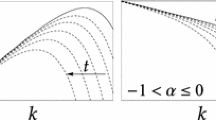Abstract
An extended structure-function model is developed by including the new effect in the p-model of Meneveau and Sreenivasan which shows that the averaged energy cascade rate changes with scale, a situation which has been found to prevail in nonfullydeveloped turbulence in the inner solar wind. This model is useful for the small-scale fluctuations in the inner heliosphere, where the turbulence is not fully developed and cannot be explained quantitatively by any of the previous intermittency turbulence models. With two model parameters, the intrinsic index of the energy spectrum <alpha>, and the fragmentation fraction P1, the model can fit, for the first time, all the observed scaling exponents of the structure functions, which are calculated for time lags ranging from 81 s to 0.7 h from the Helios solar wind data. From the cases we studied we cannot establish for P1 either a clear radial evolution trend, or a solar-wind-speed or stream-structure dependence or a systematic anisotropy for both the flow velocity and magnetic field component fluctuations. Generally, P1 has values between 0.7 and 0.8. However, in some cases in low-speed wind P1 has somewhat higher values for the magnetic components, especially for the radial component. In high-speed wind, the inferred intrinsic spectral indices (<alpha>) of the velocity and magnetic field components are about equal, while the experimental spectral indices derived from the observed power spectra differ. The magnetic index is somewhat larger than the index of the velocity spectrum. For magnetic fluctuations in both high- and low-speed winds, the intrinsic exponent <alpha> has values which are near 1.5, while the observed spectral exponent has much higher values. In the solar wind with considerable density fluctuations near the interplanetary current sheet near 1 AU, it is found that P1 has a comparatively high value of 0.89 for V x . The impact of these results on the understanding of the nature of solar wind fluctuations is discussed, and the limitations in using structure functions to study intermittency are also described.
Similar content being viewed by others
Author information
Authors and Affiliations
About this article
Cite this article
Tu, CY., Marsch, E. & Rosenbauer, H. An extended structure-function model and its application to the analysis of solar wind intermittency properties. Annales Geophysicae 14, 270–285 (1996). https://doi.org/10.1007/s00585-996-0270-9
Received:
Revised:
Accepted:
Issue Date:
DOI: https://doi.org/10.1007/s00585-996-0270-9




